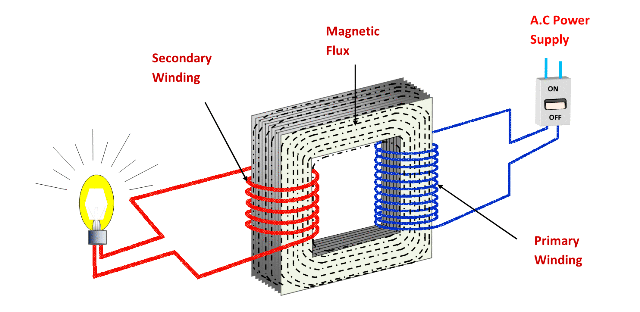📄 Print pdf
00971504825082
Alternating current part 2
An AC circuit connected in series contains an inductor, capacitor, and ohmic resistor

Capacitor in AC circuit (C)
Pure inductor in AC circuit (L)
Ohmic resistor in AC circuit (R)



 Capacitor voltage lags current by \[\frac{{{𝜋}}}{{{2}}}\]
Capacitor voltage lags current by \[\frac{{{𝜋}}}{{{2}}}\]
 Inductor voltage leads current by \[\frac{{{𝜋}}}{{{2}}}\]
Inductor voltage leads current by \[\frac{{{𝜋}}}{{{2}}}\]
 Resistor voltage is in phase with current
Resistor voltage is in phase with current



In a circuit with inductor, capacitor and ohmic resistor
Connected in series
Current is constant, current equation is of the form:
\[𝑖 (t) = 𝐼_𝑚 sin (𝜔t ± ∅ ) \]
Current may lead or lag the voltage
Question: How to find total voltage difference, total impedance, and phase angle between current and voltage?
\[ 𝑉_m(tot) ≠𝑉_𝑅 + 𝑉_𝐶 + 𝑉_𝐿 \]
\[ Z ≠𝑅 + X_𝐶 + X_𝐿 \]

In this simulation, choose an RLC circuit
Connect an inductor, resistor and capacitor in series with an AC source
Click on each component and record the values of capacitor capacitance, inductor self-inductance, ohmic resistance, maximum source voltage and source frequency
Use the ammeter and current oscilloscope to determine the maximum source current and measure the maximum current in each part of the circuit
Use the voltmeter and voltage oscilloscope to determine the maximum source voltage and maximum voltage across each component
Calculate inductive reactance and capacitive reactance
Calculate maximum voltage across each component and compare with your measurements
Use vector representation to find total voltage
Measured values
Capacitance
Self-inductance
Ohmic resistance
Maximum source current
Maximum source voltage
Source frequency
C =....
L =....
R =....
Im=....
vm=....
f = ....
Values to calculate
Capacitive reactance
\[ XC=\frac{{{1}}}{{{2𝜋fC }}\]
Inductive reactance
\[ XL=2𝜋fL \]
Maximum resistor voltage
\[ V_ R=I_ m . R \]
Maximum capacitor voltage
\[ V_ C=I_ m . XC \]
Maximum inductor voltage
\[ V_ L=I_ m . XL \]
\[ XC=......\]
\[XL=......\]
\[ V_ R=......\]
\[ V_ C=......\]
\[ V_ L=......\]
Use the calculated values treating voltages as vectors and represent them on the following graph

First find
VL - VC= ...............
The subtraction result is in the direction of the larger value
(VR ) Transfer the subtraction vector to the head of the vector
Find the resultant of the two perpendicular vectors
\[(V_ m)^2=(V_ R)^2 + ( V_ L - V_ C)^2\]
\[(V_ m)= ............\]
Calculate impedance (total circuit impedance)
( Z ) represented by the symbol
\[(V_ m)^2=(V_ R)^2 + ( V_ L - V_ C)^2\]
\[(I_ m)^2 . Z^2=(I_ R)^2 .R^2+ ( I_ L.XL - I_ C.XC)^2\]
Current is equal because connected in series, so we can simplify
\[ Z^2= R^2+ (XL - XC)^2\]
Phase angle
The angle between current and voltage difference
From the drawn vectors
\[ ∅ = tan ^-1 \frac{{{( V_ L - V_ C)}}}{{{V_ R}}}\]
Or through impedances we can calculate phase angle
\[ ∅ = tan ^-1 \frac{{{( XL - XC)}}}{{{R}}}\]
If phase angle is negative, current leads voltage
If phase angle is positive, voltage leads current

Example 1
Alternating current part 2 |

Capacitor in AC circuit (C) |
Pure inductor in AC circuit (L) |
Ohmic resistor in AC circuit (R) |
|
||
|
|
|
|
|
Capacitance Self-inductance Ohmic resistance Maximum source current Maximum source voltage Source frequency C =.... L =.... R =.... Im=.... vm=.... f = .... Capacitive reactance Inductive reactance Maximum resistor voltage Maximum capacitor voltage Maximum inductor voltage \[ XC=......\] \[XL=......\] \[ V_ R=......\] \[ V_ C=......\] \[ V_ L=......\]
In a circuit with inductor, capacitor and ohmic resistor
Connected in series
Current is constant, current equation is of the form:
\[𝑖 (t) = 𝐼_𝑚 sin (𝜔t ± ∅ ) \]
Current may lead or lag the voltage
Question: How to find total voltage difference, total impedance, and phase angle between current and voltage?
\[ 𝑉_m(tot) ≠𝑉_𝑅 + 𝑉_𝐶 + 𝑉_𝐿 \]
\[ Z ≠𝑅 + X_𝐶 + X_𝐿 \]
In this simulation, choose an RLC circuit
Connect an inductor, resistor and capacitor in series with an AC source
Click on each component and record the values of capacitor capacitance, inductor self-inductance, ohmic resistance, maximum source voltage and source frequency
Use the ammeter and current oscilloscope to determine the maximum source current and measure the maximum current in each part of the circuit
Use the voltmeter and voltage oscilloscope to determine the maximum source voltage and maximum voltage across each component
Calculate inductive reactance and capacitive reactance
Calculate maximum voltage across each component and compare with your measurements
Use vector representation to find total voltage
Measured values
Values to calculate
\[ XC=\frac{{{1}}}{{{2𝜋fC }}\]
\[ XL=2𝜋fL \]
\[ V_ R=I_ m . R \]
\[ V_ C=I_ m . XC \]
\[ V_ L=I_ m . XL \]
Use the calculated values treating voltages as vectors and represent them on the following graph

First find
VL - VC= ...............
The subtraction result is in the direction of the larger value
(VR ) Transfer the subtraction vector to the head of the vector
Find the resultant of the two perpendicular vectors
\[(V_ m)^2=(V_ R)^2 + ( V_ L - V_ C)^2\]
\[(V_ m)= ............\]
Calculate impedance (total circuit impedance)
( Z ) represented by the symbol
\[(V_ m)^2=(V_ R)^2 + ( V_ L - V_ C)^2\]
\[(I_ m)^2 . Z^2=(I_ R)^2 .R^2+ ( I_ L.XL - I_ C.XC)^2\]
Current is equal because connected in series, so we can simplify
\[ Z^2= R^2+ (XL - XC)^2\]
Phase angle
The angle between current and voltage difference
From the drawn vectors
\[ ∅ = tan ^-1 \frac{{{( V_ L - V_ C)}}}{{{V_ R}}}\]
Or through impedances we can calculate phase angle
\[ ∅ = tan ^-1 \frac{{{( XL - XC)}}}{{{R}}}\]
If phase angle is negative, current leads voltage
If phase angle is positive, voltage leads current



 Click here to show solution
Click here to show solution





0 Comments